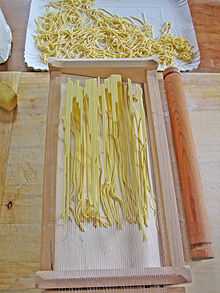Spaghetti alla chitarra

The spaghetti alla chitarra, also known as maccheroni alla chitarra, are a variety of egg pasta typical of Abruzzo, Italy. Tonnarelli are a similar pasta from Lazio.[1] They have a square cross section about 2-3 mm thick.
The tool with which this pasta is produced, called the "chitarra" (guitar), gives the pasta its name, shape, and a porous texture that allows pasta sauce to adhere well. The chitarra is a frame with a series of parallel wires crossing it.

The dough consists of durum wheat semolina, eggs, and a pinch of salt. It is then worked, and after a rest, rolled flat with a rolling pin. The dough is then placed on the "chitarra" and pushed through with the rolling pin, so that the strings of the guitar cut it into strips.[2] Pasta makers from Abruzzo bring down the cut dough by passing a finger on the pastry, as they would "play an arpeggio".[3] The "chitarra" was invented around 1890 in the province of Chieti. Before that the pasta was cut with a special rolling pin with notches to obtain its particular shape. [4]
In Abruzzo, maccheroni alla chitarra are most typically prepared with a ragout of lamb (ragù d'agnello). In particular areas of the Abruzzi the traditional condiment for this pasta is a tomato sauce with veal meatballs, so-called "pallottelle".[5]
A dried variation without egg is often marketed as spaghetti or maccheroni alla chitarra within and outside of Italy.[6][7]
See also
References
- ↑ "Tonnarelli is a local variation from Lazio.". dececco.it. Retrieved 29 September 2014.
- ↑ "Barilla". barilla.it. Retrieved 29 September 2014.
- ↑ "Italian Wikipedia". Retrieved 29 September 2014.
- ↑ "Spaghetti chitarra". pastagarofalo.it. Retrieved 29 September 2014.
- ↑ "De Cecco: accheroni alla chitarra all'uovo". dececco.it.
- ↑ "Spaghetti alla chitarra marketed outside of Italy". barilla.com.
- ↑ "Maccheroni alla chitarra (without egg) available in Italian supermarkets". dececco.it.